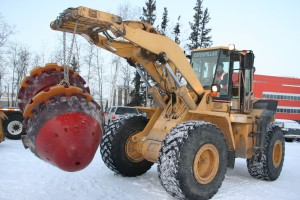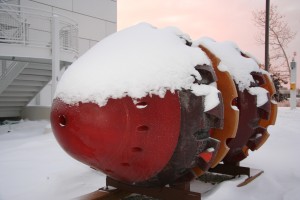Alyeska donation demonstrates pipeline innovations
January 25, 2012
Theresa Bakker
907-474-6941

1/25/12
The University of Alaska Museum of the North has installed a new pipeline super pig on its grounds.
The pig, donated to the museum’s ethnology and history collection by Alyeska Pipeline Service Company, replaces a pig given to the museum in 1984.
“That older, mostly steel and rubber pig has been on exhibit in the museum’s yard since it came to us. It sits in a vertical position in full sunlight,” said collection manager Angela Linn. “The rubber components have severely degraded over the past few years and the bumper pieces have been falling apart, so we approached Alyeska to see if they had a spare pig ready to be decommissioned.”
A pig is a device inserted into a pipeline to clean it, separate products or dewater the line; to inspect the pipeline; and to perform other special duties, such as plugging isolated pipelines. The trans-Alaska pipeline system is “pigged” every eight days.
Alyeska agreed to donate a S.U.N. Engineering “Super Pig Hybrid-B” that was in operation from about 2007 until 2010. This version has cutting devices in a configuration of disks and cups, but was decommissioned after the company transitioned to an all-disc pig in 2011.

Getting such a piece into the collection means more than having the donor drop it off, Linn said. “After many months of organization, we identified a location and then designed, custom-fabricated and installed a saddle mount.”
On Dec. 6, 2011, after more than two years of coordination, the pig was delivered.
The story of natural resource extraction is a part of Alaska’s history, Linn said. “The technology and equipment used through the entire process are a big part of telling that story.”
The comparison between the pig from the 1980s, which will be removed from exhibit this summer but preserved in an off-site facility, and the new super pig demonstrates the innovations in materials and technology that have improved efficiency in Alaska’s oil industry.
“This is one of the primary reasons we have research museums: for comparing and contrasting changes through time. Alyeska’s generous donation helps us tell this story in relation to the people of Alaska,” Linn said. “The ethnology and history collection depends on donations to expand the collection and the willingness of corporations such as Alyeska to pass along items to help us achieve our mission.”
Visitors can inspect the pipeline pig any time or day. Since it is too large to be curated inside, it is located on the northwest corner of the building, along the edge of the parking lot.
ADDITIONAL CONTACTS: Angela Linn, ethnology and history collection manager, at 907-474-1828 or via email at angela.linn@alaska.edu.
ON THE WEB: UA Museum of the North
NOTE TO EDITORS: Images are available on request.
TB/1-25-12/141-12


